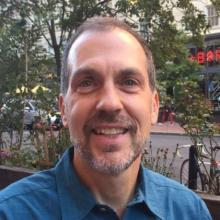
Ethan McMahon is the new Chief of Party for the Clean Air Catalyst, a flagship program launched by the U.S. Agency for International Development and a global consortium of organizations led by WRI and EDF. He brings 27 years of experience with the U.S. EPA, where he worked with cities and states to build capacity to address climate change and air pollution, and he advocated to make environmental data more accessible.
What first got you interested in environmental science, and what do you find most interesting about this field?
I started my career as a mechanical engineer, doing things such as evaluating alternative refrigerants. Within a few years I learned about the impacts of climate change and I realized that I wanted to apply my analytical skills to issues that make a difference. This work on the Catalyst interests me because it involves so many dimensions. Technology, human health, collaboration–you need all of these ingredients and more to affect change on many environmental issues.
Why is open, publicly available data so crucial for solving environmental problems?
It’s hard to solve environmental issues because the causes and effects are complicated. In order to present a convincing case to decision-makers you need to speak their language, using numbers and sometimes stories. But you can only crunch the numbers if you can get the data, so it’s critical that data collectors make their data accessible and usable.
If governments collect data for one purpose, it makes sense to get more value out of the data by making it available for other purposes. For example, EPA collects data on air quality for regulatory purposes, but community groups may want to use that same data to understand if their air quality has suddenly shifted to be worse. AirNow is a great example of how EPA makes their data available for non-regulatory purposes.
How can more data on air quality improve people’s lives?
Air quality affects some portions of the public more than others. For example, some people can only afford to live or work where pollution levels are high, such as near power plants, roadways or outdoor waste burning. The Clean Air Catalyst is finding ways to help people in the pilot cities (Jakarta, Indonesia; Indore, India; and soon, a third city). We use data from existing air quality monitors and analyze where the pollution is coming from. Then we increase awareness of the pollution – and ask people what they experience in their daily lives. Then we collect more air quality data to complement the existing monitors. After we analyze a few dimensions – health, climate change and gender – we evaluate which actions provide lasting benefits and work with communities to implement them.
Is there something about air quality monitoring that you’re especially excited about right now?
I’m really excited about people using data to affect change. They’re thinking beyond the accuracy of individual sensors and focusing instead on how they can use data to make decisions. That’s where the true value is, the benefit to health and society. Communities can use data from a few nearby sensors to understand if air quality is getting better or worse. That might be enough information for people to change their habits and protect themselves, for example by not exercising during hours when pollution levels are high.
What are some goals you have for the Clean Air Catalyst program?
I want the Clean Air Catalyst program to help cities improve their air quality in ways that are effective and sustainable. We’re using a lot of innovative methods in our pilot cities so we don’t exactly know which activities will be the most successful. However, we’ll learn from the experience and share the lessons with other cities so they can make progress easier. In parallel, we’re fostering two types of coalitions. First, we’re bringing several sectors together at the local level. Second, we’re connecting global and local experts so they can collaborate about feasible interventions. Follow our progress and feel free to suggest ways to make lasting improvements to air quality.
Learn more about the Clean Air Catalyst program here.
